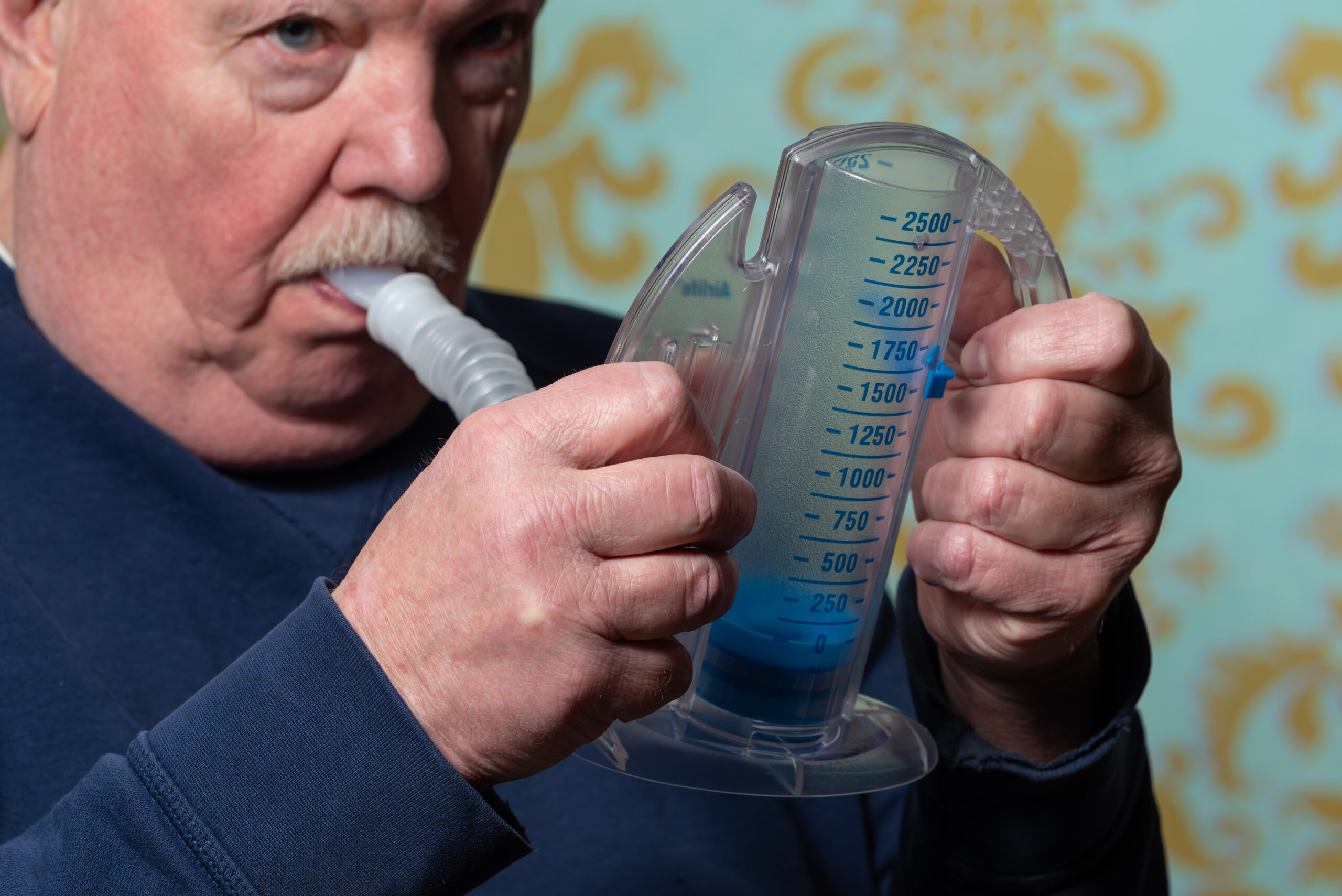What is COPD?
Chronic Obstructive Pulmonary Disease (COPD) is a group of progressive lung diseases that cause breathing difficulties due to obstructed airflow in the lungs. The most common conditions that fall under the umbrella of COPD are emphysema and chronic bronchitis.
Emphysema involves damage to the air sacs (alveoli) in the lungs, which leads to a reduction in the surface area available for gas exchange. This results in shortness of breath and reduced oxygen levels in the blood.
Chronic bronchitis is characterized by inflammation and narrowing of the bronchial tubes, leading to excessive mucus production, coughing, and difficulty breathing.
The primary cause of COPD is long-term exposure to lung irritants, with cigarette smoking being the most common risk factor. Other risk factors include exposure to air pollution, occupational dust and chemicals, and genetic factors.
COPD is a progressive disease that typically worsens over time. While there is no cure for COPD, treatments and lifestyle changes can help manage symptoms, improve quality of life, and slow the progression of the disease. Treatment options may include medications, pulmonary rehabilitation, oxygen therapy, and in severe cases, surgery or lung transplantation.
How does COPD occur?
COPD occurs as a result of long-term exposure to irritants that damage the lungs and airways, leading to inflammation, obstruction, and decreased lung function. The main causes and risk factors for COPD are:
- Cigarette smoking: This is the most significant risk factor for COPD, as the chemicals in cigarette smoke cause irritation and inflammation in the airways and damage the delicate structures of the lungs, like the alveoli.
- Exposure to air pollution: Long-term exposure to outdoor air pollution, as well as indoor air pollution from burning biomass fuels (like wood, coal, or crop residue) for cooking and heating, can contribute to COPD.
- Occupational exposure: Some people develop COPD due to prolonged exposure to dust, chemicals, and fumes in their work environment. Occupations at risk include mining, construction, farming, and jobs involving contact with chemicals or other irritants.
- Genetic factors: A small percentage of people with COPD have a genetic predisposition to the disease. One well-known genetic condition is alpha-1 antitrypsin deficiency (AATD), which causes a deficiency of the alpha-1 antitrypsin protein, increasing the risk of developing COPD.
- Age and gender: COPD is more common in people over 40 years old, as the risk increases with age and cumulative exposure to lung irritants. Historically, men have been at higher risk for COPD, but the prevalence among women has been increasing due to changes in smoking patterns.
- Asthma: People with a history of asthma may be at a higher risk of developing COPD, especially if they smoke or have a history of smoking.
The damage to the lungs and airways caused by these factors leads to the development of emphysema and/or chronic bronchitis, the two main conditions that comprise COPD. Over time, the airway obstruction and damage to the lung tissue worsen, making it increasingly difficult to breathe and resulting in reduced oxygen levels in the blood.
What’s the difference between chronic bronchitis and emphysema?
Chronic bronchitis and emphysema are the two main conditions that fall under the umbrella of Chronic Obstructive Pulmonary Disease (COPD). While both conditions cause breathing difficulties and share some common risk factors, they differ in terms of the primary affected lung structures and their specific symptoms.
Chronic bronchitis:
- Primarily affects the bronchial tubes, which carry air in and out of the lungs.
- Inflammation and narrowing of the bronchial tubes occur, leading to excessive mucus production.
- Persistent cough that produces mucus (phlegm) for at least three months per year for two consecutive years.
- Symptoms include a productive cough, wheezing, chest tightness, and shortness of breath.
Emphysema:
- Primarily affects the air sacs (alveoli) in the lungs, which are responsible for gas exchange.
- Damage to the alveolar walls results in the loss of their elastic properties and the collapse of small airways.
- Reduced surface area for gas exchange causes decreased oxygen levels in the blood and shortness of breath.
- Symptoms include shortness of breath (especially during physical activity), a barrel-shaped chest, and pursed-lip breathing.
It is important to note that many people with COPD have a combination of both chronic bronchitis and emphysema. Although the symptoms and affected lung structures differ, the treatment and management strategies for both conditions often overlap, focusing on relieving symptoms, improving lung function, and slowing the progression of the disease.
What symptoms does a patient experience with COPD?
Patients with COPD experience a variety of symptoms that typically worsen over time, as the disease progresses. Some common symptoms include:
- Shortness of breath (dyspnea): This is often the first and most noticeable symptom of COPD. Patients may initially experience shortness of breath during physical activities, but as the disease progresses, it may also occur during rest.
- Chronic cough: A persistent cough that produces mucus (phlegm) is a common symptom, especially in those with chronic bronchitis. The cough may last for several months or years.
- Increased mucus production: Patients with COPD often produce more mucus than usual, which can lead to frequent throat clearing or a productive cough.
- Wheezing: A whistling sound during breathing is often present in COPD patients, particularly during exhalation. This is caused by the narrowing of airways and increased resistance to airflow.
- Chest tightness: COPD patients may experience a sensation of tightness or pressure in the chest, which can be uncomfortable or even painful.
- Fatigue: Patients with COPD often feel tired or weak due to the increased effort required to breathe and decreased oxygen levels in the blood.
- Frequent respiratory infections: COPD patients are more prone to lung infections, like pneumonia and bronchitis, which can exacerbate symptoms and worsen the disease.
- Weight loss: In advanced stages of COPD, patients may experience unintentional weight loss due to the increased energy expenditure required for breathing and decreased appetite.
- Cyanosis: In severe cases, a bluish tint around the lips, fingertips, or nail beds may be observed due to low oxygen levels in the blood.
It is important to note that the severity and combination of symptoms can vary among individuals with COPD. If you or someone you know is experiencing any of these symptoms, it is crucial to consult a healthcare professional for an accurate diagnosis and appropriate treatment plan.
How is COPD diagnosed?
COPD is diagnosed through a combination of clinical evaluation, medical history, physical examination, and various tests. The diagnostic process typically involves the following steps:
- Medical history: The healthcare provider will ask about the patient’s symptoms, personal and family medical history, exposure to lung irritants (such as smoking, air pollution, or occupational exposure), and any history of lung infections or asthma.
- Physical examination: The doctor will listen to the patient’s lungs using a stethoscope to detect abnormal breath sounds, such as wheezing or crackles, and look for physical signs of COPD, such as cyanosis (bluish discoloration of the lips or fingertips) or a barrel-shaped chest.
- Spirometry: This is the most common and essential test to diagnose COPD. Spirometry measures the volume and flow of air a person can inhale and exhale. The patient is asked to take a deep breath and forcefully exhale into a mouthpiece connected to the spirometer. The test results help to determine the presence and severity of airflow obstruction, which is a hallmark of COPD.
- Chest X-ray or CT scan: These imaging tests can help visualize the lungs and check for signs of COPD, such as hyperinflation or flattened diaphragms. They can also rule out other lung conditions or detect complications like pneumonia.
- Arterial blood gas (ABG) test: This test measures the oxygen and carbon dioxide levels in the blood, which can indicate how well the lungs are functioning and provide information about the severity of the disease.
- Complete blood count (CBC): A CBC may be performed to check for anemia or other blood abnormalities that can be associated with COPD.
- Alpha-1 antitrypsin deficiency (AATD) testing: In some cases, especially when COPD occurs in younger patients or those with a family history, genetic testing may be done to determine if there is an inherited deficiency of the alpha-1 antitrypsin protein, which can increase the risk of COPD.
- Other tests: Depending on the patient’s symptoms and risk factors, additional tests like lung function tests, exercise tests, or sputum examination may be performed to further assess the condition or rule out other lung diseases.
Based on the results of these evaluations and tests, a healthcare provider can diagnose COPD, determine its severity, and develop an appropriate treatment plan for the patient. Early diagnosis and proper management of COPD are crucial to improve quality of life, reduce symptoms, and slow the progression of the disease.
What is the treatment for COPD?
There is no cure for COPD, but a combination of treatments and lifestyle changes can help manage symptoms, improve quality of life, and slow the progression of the disease. The treatment plan for a COPD patient may include:
- Medications:
- Bronchodilators: These drugs help relax and open the airways, making it easier to breathe. They are usually administered via inhalers or nebulizers and are available in short-acting and long-acting formulations.
- Inhaled corticosteroids: These medications help reduce inflammation in the airways and are often prescribed for patients with more severe COPD or frequent exacerbations.
- Oral corticosteroids: These may be prescribed for short-term use during acute exacerbations or severe cases of COPD.
- Phosphodiesterase-4 (PDE4) inhibitors: These oral medications help reduce inflammation and are typically prescribed for patients with severe COPD and chronic bronchitis symptoms.
- Mucolytics: These medications help thin the mucus in the airways, making it easier to cough up and clear.
- Antibiotics: These may be prescribed to treat bacterial infections that can exacerbate COPD symptoms.
- Pulmonary rehabilitation: This is a comprehensive program that includes exercise training, education about COPD, nutrition counseling, and psychological support. Pulmonary rehabilitation helps improve physical fitness, reduce symptoms, and enhance the overall quality of life for COPD patients.
- Oxygen therapy: Some patients with moderate to severe COPD may require supplemental oxygen to maintain adequate oxygen levels in the blood. Oxygen therapy can be delivered through a nasal cannula or mask and can be used at home, during exercise, or while sleeping.
- Lifestyle changes:
- Smoking cessation: Quitting smoking is the most critical step in preventing further lung damage and slowing the progression of COPD.
- Avoiding lung irritants: Minimizing exposure to air pollution, dust, chemical fumes, and secondhand smoke can help reduce COPD symptoms and prevent exacerbations.
- Exercise: Regular physical activity can improve lung function, endurance, and overall well-being for COPD patients.
- Nutrition: Eating a balanced diet and maintaining a healthy weight can help support lung function and overall health.
- Vaccinations: COPD patients should receive vaccinations for influenza and pneumococcal pneumonia to reduce the risk of respiratory infections, which can worsen COPD symptoms.
- Surgical interventions: In severe cases or when other treatments fail to provide adequate relief, surgical options may be considered, such as lung volume reduction surgery, bullectomy, or lung transplantation.
COPD treatment plans should be individualized based on the patient’s specific needs, disease severity, and underlying health conditions. Regular follow-ups with a healthcare provider are essential to monitor the disease’s progression, adjust treatments as necessary, and address any complications that may arise.
What are the typical outcomes for COPD treatment?
COPD is a progressive and chronic disease, and while there is no cure, treatment and lifestyle changes can help manage symptoms, improve quality of life, and slow the progression of the disease. The outcomes of COPD treatment can vary depending on the severity of the disease, the patient’s adherence to the treatment plan, and the presence of other underlying health conditions. Typical outcomes for COPD treatment may include:
- Symptom management: Medications, such as bronchodilators and inhaled corticosteroids, can help reduce symptoms like shortness of breath, cough, and wheezing, making it easier for patients to breathe and perform daily activities.
- Improved exercise capacity: Pulmonary rehabilitation programs and regular physical activity can help improve lung function, endurance, and overall fitness, enabling patients to participate in activities they enjoy and maintain a better quality of life.
- Reduced exacerbations: Proper management of COPD, including medication adherence, vaccinations, and avoidance of lung irritants, can help reduce the frequency and severity of COPD exacerbations, which are periods when symptoms worsen significantly.
- Better overall health: Lifestyle changes, such as smoking cessation, maintaining a healthy weight, and eating a balanced diet, can contribute to better overall health and well-being for COPD patients.
- Slower disease progression: While COPD is progressive, adherence to treatment plans and lifestyle changes can help slow the decline in lung function over time.
It is essential to note that the outcomes of COPD treatment can vary among individuals, and the disease may continue to progress despite treatment. COPD patients should work closely with their healthcare providers to develop and adjust individualized treatment plans that address their specific needs and monitor the progression of the disease. Regular follow-ups and proactive management of COPD can help optimize treatment outcomes and enhance the quality of life for patients.
What questions should I ask my doctor if I’m diagnosed with COPD?
If you are diagnosed with COPD, it’s essential to communicate openly with your healthcare provider to ensure you understand your condition and the necessary steps to manage it effectively. Here are some questions you may consider asking your doctor:
- What stage is my COPD, and how severe is it?
- What is the primary cause of my COPD, and are there any identifiable risk factors that may have contributed to its development?
- What lifestyle changes should I make to help manage my COPD and improve my overall health? For example, smoking cessation, exercise, diet, or avoiding environmental triggers.
- What medications will I be prescribed, and how do they work? What are the potential side effects, and how should I take them properly?
- Should I participate in a pulmonary rehabilitation program, and if so, can you recommend one?
- Will I need supplemental oxygen therapy, and if so, how and when should I use it?
- What vaccinations should I receive to help prevent respiratory infections?
- How can I recognize the signs of a COPD exacerbation, and what steps should I take if one occurs?
- What is the long-term prognosis for my COPD, and how can I expect it to progress over time?
- How often should I schedule follow-up appointments and lung function tests to monitor my COPD?
- Are there any support groups or resources available to help me cope with the emotional and psychological aspects of living with COPD?
Feel free to ask any additional questions or address concerns you may have about your condition. It’s crucial to maintain an open dialogue with your healthcare provider to ensure you receive the appropriate care and support to manage your COPD effectively.




